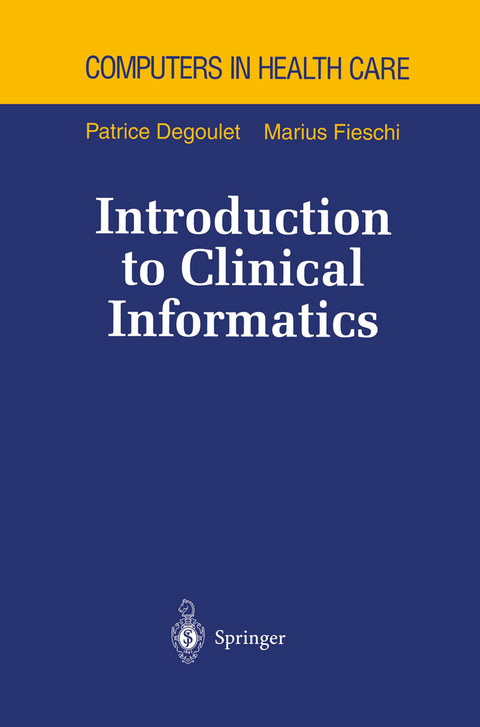
Introduction to Clinical Informatics
Springer-Verlag New York Inc.
978-1-4612-6865-9 (ISBN)
1. Systems for Managing Medical Information.- Principles of Computer Operations.- Hardware Architecture.- Software Architecture.- Communications and Networks.- Integrated System Architectures.- Exercises.- 2. Medical Software Development.- Computer Project Management.- Conceptual Models.- Software Development Tools.- Electronic Data Interchange.- Integrating Software Components.- Exercises.- 3. Medical Data and Semiology.- The Nature of Medical Data.- Interpreting Medical Data.- Quantitative Semiology.- Discussion and Conclusions.- Exercises.- 4. Medical Reasoning and Decision-Making.- Reasoning.- The Steps Involved in Making a Medical Decision.- Uncertainty and Medical Judgment.- Probability Theory and Decision Analysis.- Symbolic Reasoning and Expert Systems.- Learning.- Discussion and Conclusion.- Exercises.- 5. Medical Language and Classification Systems.- Coding and Classifications.- Examples of Classifications.- Discussion and Conclusion.- Exercises.- 6. Documentation Systems and Information Databases.- Technical Infrastructure.- General Characteristics.- Documentation Systems.- Discussion and Conclusion.- Exercises.- 7. Hospital Information Systems.- Analysis of the Information System.- The Components of an HIS.- Strategies and Technical Solutions.- Required Resources.- Discussion and Conclusion.- Exercises.- 8. Health-Care Networks.- The Health System.- Health-Care Networks and Health Information Systems.- The Information System for Generalists.- The Patient’s Information System.- Discussion and Conclusion.- Exercises.- 9. Managing Patient Records.- Different Views of Patient Records.- Objectives and Expected Benefits.- Modeling Medical Information.- Implementing Computerized Medical Records.- Discussion and Conclusion.- Exercises.- 10. Physiological SignalProcessing.- Importance and Objectives.- Basic Signal Processing Concepts.- Sample Medical Applications.- Discussion and Conclusion.- Exercises.- 11. Medical Imaging Systems.- Importance and Objectives.- Image Acquisition Sources.- Digitized Images.- Basic Image Processing Principles.- Sample Medical Applications.- Imaging Management and Communication Systems.- Discussion and Conclusion.- Exercises.- 12. Medical Decision Support Systems.- Characteristics of Decision Support Systems.- Methodological Basis of Decision Support Systems.- Implementing Decision Support Systems.- Sample Decision Support Systems.- Discussion and Conclusion.- Exercises.- 13. Computer-Based Education.- The Need for a Global Pedagogical Approach.- The Role of Computer-Based Education.- Methods and Implementations.- Discussion and Conclusion.- Exercises.- 14. Analysis and Control of Medical Activity.- Controlling Health-Care Expenses.- Evaluation, Control, and Quality.- Methods and Principles for Analyzing Medical Activity.- Analyzing Medical Activity in the Hospital.- Discussion and Conclusion.- Exercises.- 15. Security and Data Protection.- Identifying the Risks.- Protecting Data Concerning Individuals.- Discussion and Conclusion.- Exercises.- Appendix A. Review of Probabilities.- Conditional Probabilities.- Baves’ Formula.- Rc ‘ative Risk and Odds Ratio.- Appendix B. Review of Logic.- Prepositional Logic.- Predicate Logic.- Appendix C. Some Useful References.- Medical Informatics Associations.- In France.- In Europe.- In the United States.- The International Medical Informatics Association.- Principal International Conferences.- Principal Specialized Publications.- Internet Addresses.- General Catalogs and Electronic Libraries.- Informatics in Health Care and Telemedicine, Standards.-Medical Informatics Textbooks.- Data and Knowledge Banks.- Medical guidelines, Evidence-Based Medicine.
| Erscheint lt. Verlag | 17.10.2012 |
|---|---|
| Reihe/Serie | Health Informatics |
| Übersetzer | B. Phister |
| Zusatzinfo | XIX, 247 p. |
| Verlagsort | New York, NY |
| Sprache | englisch |
| Maße | 155 x 235 mm |
| Themenwelt | Mathematik / Informatik ► Informatik |
| Medizin / Pharmazie | |
| Technik ► Medizintechnik | |
| ISBN-10 | 1-4612-6865-6 / 1461268656 |
| ISBN-13 | 978-1-4612-6865-9 / 9781461268659 |
| Zustand | Neuware |
| Haben Sie eine Frage zum Produkt? |
aus dem Bereich


